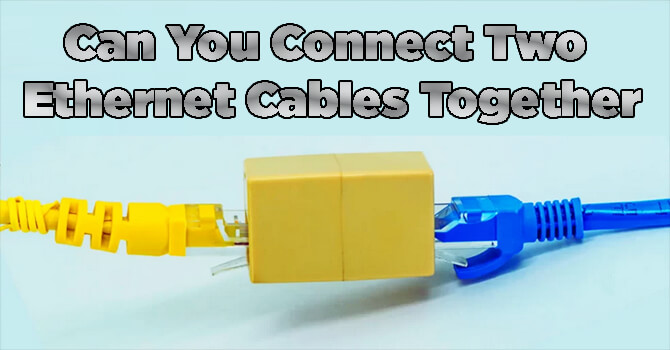In the world of modern connectivity, Ethernet cables serve as the lifelines that keep our devices communicating seamlessly. However, what do you do when the standard length of an Ethernet cable falls short of your networking needs? Can you connect two Ethernet cables together? We will discuss the why, how, when, and pros and cons of joining two Ethernet cables.

Why Connect Two Ethernet Cables Together?
The need to connect two Ethernet cables arises from various practical scenarios. One of the most common reasons is the limitation in the standard length of Ethernet cables, typically around 100 meters. Here are some key situations where connecting two Ethernet cables becomes essential:
Extended Distance Requirements:
When the distance between your router and the device you want to connect exceeds the standard cable length, joining two cables becomes a practical solution.
Temporary Setups:
For events, conferences, or situations where a temporary network connection is required, connecting two Ethernet cables offers a flexible and quick solution.
Cable Troubleshooting:
Rather than replacing an entire cable, connecting two shorter ones can serve as a rapid diagnostic and resolution method for identifying and addressing cable issues.
Convenience in Installation:
In instances where running a new, longer cable is impractical or inconvenient, joining two shorter cables can be a convenient alternative, saving time and effort.
How to Connect Two Ethernet Cables Together –
Connecting two Ethernet cables is a straightforward process that requires a device known as an Ethernet coupler or joiner. Follow these steps to seamlessly merge two Ethernet cables:
Step 1: Gather the Necessary Equipment
Ensure you have two Ethernet cables of the same category (e.g., Cat5e, Cat6) and an Ethernet coupler.
Step 2: Inspect the Cables
Before connecting, carefully inspect both Ethernet cables for any visible damage to the connectors or the cable itself. Damaged cables can lead to a loss in signal quality.
Step 3: Connect the Ethernet Cables
- Insert one end of the first Ethernet cable into one side of the Ethernet coupler.
- Insert the other end of the first cable into the device or router.
- Repeat the process with the second Ethernet cable, connecting it to the opposite side of the coupler.
- Ensure that the connectors are securely inserted to avoid signal loss.
Step 4: Test the Connection
After connecting the cables, test the connection by checking the device’s network settings or using network diagnostic tools. Confirm that the joined cables provide a stable and reliable connection.
When to Connect Two Ethernet Cables Together?
Connecting two Ethernet cables is a practical solution in various scenarios. Here are some common situations when this method proves beneficial:
1. Extended Distance Requirements:
When the distance between your router and device exceeds the standard cable length, connecting two cables becomes essential for maintaining a reliable connection.
2. Temporary Setups:
For events, conferences, or temporary networking requirements, joining two Ethernet cables allows for quick and flexible network deployment.
3. Cable Troubleshooting:
When dealing with cable issues, connecting two shorter cables aids in the quick identification and resolution of problems without the need for extensive rewiring.
4. Convenience in Installation:
In situations where running a new, longer cable is impractical or not feasible, connecting two shorter cables provides a convenient alternative for extending network reach.
Pros of Connecting Two Ethernet Cables –
Understanding the advantages of connecting two Ethernet cables helps in making informed decisions. Here are the pros of this method:
1. Cost-Effective Solution:
Using an Ethernet coupler to join two cables is often more cost-effective than purchasing a longer cable, especially for temporary setups.
2. Versatility:
Connecting two Ethernet cables offers flexibility in network design and setup, making it an ideal solution for dynamic environments where changes are frequent.
3. Quick Troubleshooting:
It serves as a quick fix for identifying and resolving cable issues without the need for extensive rewiring or replacing an entire cable.
4. Adaptability:
Allows for adapting to changing network requirements without the need for major infrastructure changes, offering a versatile solution.
Cons of Connecting Two Ethernet Cables –
While connecting two Ethernet cables provides practical solutions, it is essential to consider the potential drawbacks:
1. Signal Quality:
The more connectors and joins in a cable, the higher the potential for signal degradation. To minimize this risk, it’s crucial to use high-quality couplers.
2. Aesthetics:
Multiple joins in a cable setup can appear messy and may not be suitable for situations where a clean and organized appearance is essential.
3. Potential for Interference:
Joining cables increases the likelihood of electromagnetic interference, especially if the cables run parallel to power lines or other sources of interference.
4. Limited Length Extension:
While joining two cables provides additional length, there are practical limits to how far you can extend a network using this method. For extensive network expansion, other solutions may be more suitable.
